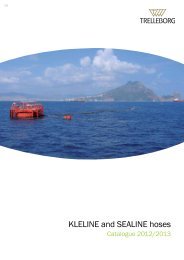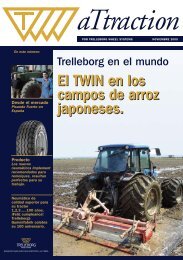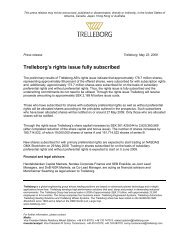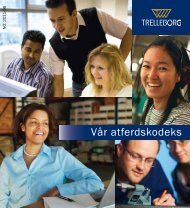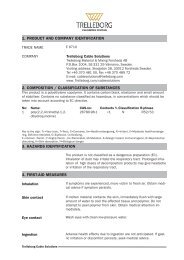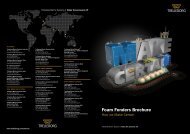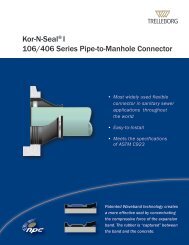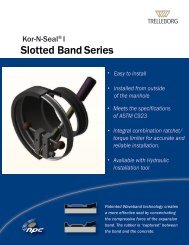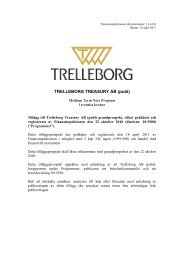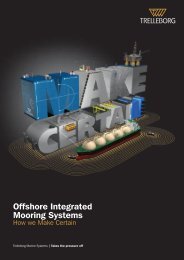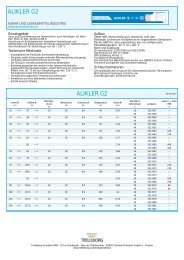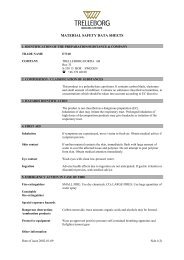Annual report 2011 - Trelleborg
Annual report 2011 - Trelleborg
Annual report 2011 - Trelleborg
You also want an ePaper? Increase the reach of your titles
YUMPU automatically turns print PDFs into web optimized ePapers that Google loves.
FINANCIAL DEFINITIONS<br />
AND GLOSSARY<br />
Financial key figures<br />
Debt/equity ratio Net debt divided by total equity.<br />
Earnings per share Profit for the period, attributable to<br />
shareholders of the Parent Company divided by the<br />
average number of shares outstanding.<br />
Earnings per share after dilution Profit for the period,<br />
attributable to shareholders of the Parent Company<br />
divided by the average number of shares outstanding<br />
plus the average number of shares added through<br />
the conversion of outstanding debentures and warrants.<br />
Equity/assets ratio Total equity divided by total assets.<br />
Free cash flow Operating cash flow and cash flow from<br />
financial items and tax and the effect of restructuring<br />
measures on cash flow.<br />
Free cash flow per share Free cash flow divided by the<br />
average number of shares outstanding.<br />
Net debt Interest-bearing liabilities less interest-bearing<br />
assets and cash and cash equivalents.<br />
P/E ratio Market price divided by earnings per share.<br />
Return on shareholders’ equity Profit for the period,<br />
attributable to shareholders of the Parent Company<br />
as a percentage of average shareholders’ equity,<br />
excluding non-controlling interests.<br />
Yield Dividend as a percentage of the market price.<br />
GLOSSARY<br />
BRIC countries Brazil, Russia, India, China.<br />
Brake shims Rubber metal alloy rings attached to the<br />
brake lining (to minimize screech).<br />
CDP (Carbon Disclosure Project), an independent organization<br />
with the world’s largest database of climate<br />
information. On behalf of global investors, the CDP<br />
gathers information regarding emissions of greenhouse<br />
gases by companies and organizations as well<br />
as the measures being taken by them to prevent a<br />
negative climate impact.<br />
CR (Corporate responsibility) Refers to the responsibilities<br />
of companies towards their key stakeholders, such<br />
as employees, shareholders, customers, suppliers,<br />
the local community and the environment. Often relates<br />
to the same areas encompassed by the term<br />
sustainability or Corporate Social Responsibility (CSR).<br />
Global Compact UN initiative that unites companies and<br />
social institutions around ten universally applicable<br />
principles for environment and society. The aim is for<br />
companies to become members of society that are<br />
involved in developing solutions for challenges arising<br />
from increasing globalization.<br />
GRI (Global Reporting Initiative) A global network in which<br />
community representatives, industries, investors and<br />
others cooperate to create and improve the approaches<br />
to sustainability <strong>report</strong>ing, on a consensus basis.<br />
Operating key figures *<br />
Average number of employees Average number of<br />
employees during the year based on hours worked.<br />
Does not include insourced staff.<br />
Capital employed Total assets less interest-bearing financial<br />
assets and cash and cash equivalents and<br />
noninterest-bearing operating liabilities (including<br />
pension liabilities) and excluding tax assets and tax<br />
liabilities.<br />
Earnings per share Profit for the period, attributable to<br />
shareholders of the Parent Company, excluding items<br />
affecting comparability net after tax, divided by the<br />
average number of shares outstanding.<br />
EBIT Operating profit according to the income statement,<br />
excluding items affecting comparability.<br />
EBITDA Operating profit excluding depreciation and<br />
amortization of PPE and intangible assets, and items<br />
affecting comparability.<br />
EBITDA/Net interest income/expense EBITDA divided<br />
by net interest income/expense (interest income less<br />
interest expenses).<br />
EBITDA margin EBITDA excluding profit from participation<br />
in associated companies as a percentage of net<br />
sales.<br />
Net debt/EBITDA Net debt divided by EBITDA.<br />
Number of employees at year-end Including insourced<br />
staff and temporary employees.<br />
Operating cash flow EBITDA excluding undistributed<br />
participation in the earnings of associated compa-<br />
ISO (International Organization for Standardization), an<br />
international standardization body that works with<br />
industrial and commercial standards. The following<br />
standards are applied at <strong>Trelleborg</strong>; ISO 9000 which<br />
provides guidelines for quality assurance systems,<br />
ISO 14001 that sets requirements and provides guidance<br />
regarding environmental management systems<br />
and ISO 26000 which forms a practical set of guidelines<br />
and standards for increasing responsibility in<br />
the process to obtaining sustainable development.<br />
NVH (Noise, Vibration, Harshness) An overall term for<br />
noise, vibration and sudden movements that the car<br />
driver and passengers experience as unpleasant. A<br />
car with low NVH values is experienced as comfortable.<br />
OEM (Original Equipment Manufacturer) The end producer<br />
of, for example, a car.<br />
Plastics can be divided into two main groups. Thermoplastics<br />
are non-cross-linked plastics that are solid<br />
at room temperature but become soft and moldable<br />
when heated. Hard plastics are cross-linked plastics<br />
that disintegrate upon heating and do not regain their<br />
properties.<br />
Polymer The word is derived from the Greek “poly,”<br />
meaning “many” and “meros” meaning “parts.” Polymers<br />
are made up of many small molecules – monomers<br />
– that are linked in long chains. Examples of<br />
polymers are plastics and rubber.<br />
FINANCIAL DEFINITIONS AND GLOSSARY<br />
nies, investments and changes in working capital but<br />
excluding cash flow pertaining to restructuring.<br />
Operating cash flow/Operating profit Operating cash<br />
flow as a percentage of operating profit, excluding<br />
items affecting comparability.<br />
Operating cash flow per share Operating cash flow<br />
divided by the average number of shares outstanding.<br />
Operating margin (ROS – Return On Sales)<br />
– Operating profit excluding participation in the earnings<br />
of associated companies and items affecting comparability<br />
as a percentage of net sales.<br />
– Operating profit excluding participation in the earnings<br />
of associated companies but including items affecting<br />
comparability as a percentage of net sales.<br />
Operating profit Operating profit as stated in the income<br />
statement excluding items affecting comparability.<br />
Rate of capital turnover Net sales as a percentage of<br />
average capital employed.<br />
Return on capital employed (ROCE) Operating profit<br />
divided by the average capital employed.<br />
Return on shareholders’ equity Profit for the period,<br />
attributable to shareholders of the Parent Company,<br />
excluding items affecting comparability, net after tax,<br />
divided by average shareholders’ equity, excluding<br />
non-controlling interests.<br />
Western Europe Austria, Belgium, Denmark, Finland,<br />
France, Germany, Greece, Iceland, Ireland, Italy,<br />
Luxemburg, Malta, the Netherlands, Norway, Portugal,<br />
Sweden, Switzerland, Spain, the UK.<br />
*) for continuing operations<br />
Polymer technology The technology relating to manufacturing<br />
processes for polymers in combination with<br />
their unique properties.<br />
REACH (Registration, Evaluation and Authorization of<br />
Chemicals). The aim of the EU’s REACH chemicals<br />
ordinance is to only permit the use of substances in<br />
the EU and EEA that are registered with the European<br />
Chemicals Agency.<br />
Safety@Work A program of preventative measures to<br />
forestall injuries and illness at all of <strong>Trelleborg</strong>’s<br />
workplaces. The program supports the organizational<br />
change that is required to create a culture of safety<br />
and strengthens the Group’s ability to attract, develop<br />
and retain employees in all its units.<br />
<strong>Annual</strong> Report <strong>2011</strong> <strong>Trelleborg</strong> AB 107




